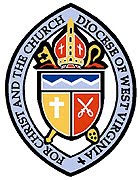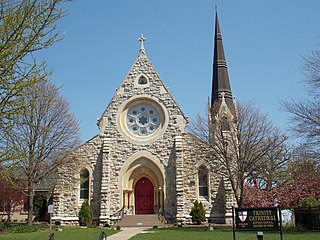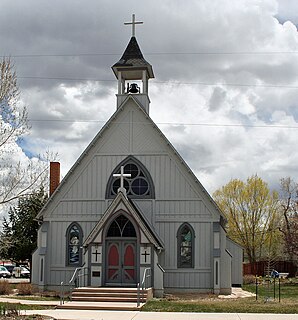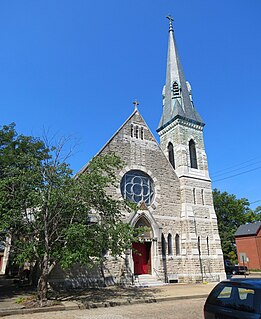
The Town of Marble is a Statutory Town in Gunnison County, Colorado, United States. The town population was 131 at the 2010 United States Census.

The Diocese of Fond du Lac is a diocese of the Episcopal Church in the United States of America, encompassing the northeastern third of Wisconsin. The diocese contains about 4,700 baptized members worshiping in 36 locations. It is part of Province 5. Diocesan offices are in Appleton, Wisconsin as are the diocesan Archives. Matthew Gunter is its bishop.

St. Michael's Church is a historic Episcopal church at 225 West 99th Street and Amsterdam Avenue on Manhattan's Upper West Side in New York City. The parish was founded on the present site in January 1807, at that time in the rural Bloomingdale District. The present limestone Romanesque building, the third on the site, was built in 1890–91 to designs by Robert W. Gibson and added to the National Register of Historic Places in 1996.

The Episcopal Diocese of West Virginia is a diocese of the Episcopal Church in the United States of America (TEC). It encompasses all 55 counties of West Virginia. The diocese has 66 congregations, including 38 parishes, 26 missions, and 2 other churches. The diocese is headquartered in Charleston and led by the Rt. Rev. W. Michie Klusmeyer who was consecrated as its bishop diocesan in 2001.

St. James' Episcopal Church, named for James the Greater, is a historic Episcopal church located in Manitowoc, Wisconsin. The only Episcopal church in Manitowoc County, St. James' is a "broad church" parish in the Diocese of Fond du Lac. It is the oldest continually operating congregation in Manitowoc County, first meeting in 1841. and organizing in 1848. The current church building, an example of Gothic Revival architecture, was consecrated in 1902. The congregation is active in community service and social justice ministries.

St. John's Cathedral is an Episcopal church near downtown Los Angeles that serves as both a parish church and the cathedral church of the Episcopal Diocese of Los Angeles, an area covering five and a half counties. Though St. John's was formed in 1890, the current Romanesque Revival architectural style church was built in 1925. It was listed in the National Register of Historic Places in 2000.

St. Paul's Protestant Episcopal Church, more commonly called Old St. Paul's Church today, is a historic Episcopal church located at 233 North Charles Street at the southeast corner with East Saratoga Street, in Baltimore, Maryland, near "Cathedral Hill" on the northern edge of the downtown central business district to the south and the Mount Vernon-Belevedere cultural/historic neighborhood to the north. It was founded in 1692 as the parish church for the "Patapsco Parish", one of the "original 30 parishes" of the old Church of England in colonial Maryland.

St. John's is an Episcopal church located in Hampton, Virginia, United States, within the Episcopal Diocese of Southern Virginia. Established in 1610, St. John's is the oldest English-speaking parish in continuous existence in the United States of America.

St. Mark's Episcopal Church was a historic church at 9 Summer Street in Augusta, Maine, just west of downtown. The congregation, founded in 1840, occupied an 1886 Gothic Revival stone building designed by Richard M. Upjohn and listed on the National Register of Historic Places in 1984 for its architecture. The congregation moved out in 2015.

St. James' Episcopal Church is a congregation of the Episcopal Church in La Grange, Texas, under the Episcopal Diocese of Texas. Its campus at Monroe and Colorado Streets includes its historic parish church as well as a sacristy, preschool, and parish hall.

Trinity Episcopal Cathedral, formerly known as Grace Cathedral, is the historic cathedral in the Diocese of Iowa. The cathedral is located on the bluff overlooking Downtown Davenport, Iowa, United States. Completed in 1873, Trinity is one of the oldest cathedrals in the Episcopal Church in the United States. It was individually listed on the National Register of Historic Places in 1974. In 1983 the cathedral was included as a contributing property in the College Square Historic District, which is also listed on the National Register.

St. Barnabas Episcopal Church is a former church building in the Episcopal Diocese of Iowa located in Montrose, Iowa, United States. It was listed on the National Register of Historic Places in 1986. The building is now called St. Barnabas Wedding Chapel.

St. Paul's Episcopal Church is a parish church in the Diocese of Iowa. The church is located in Durant, Iowa, United States. The church building and parish hall have been listed on the National Register of Historic Places since 1985.

St. Philips Episcopal Church, also known as St. Philips Church, is a historic Episcopal church located on NC 65 and 8 and SR 1957 in Germanton, Stokes County, North Carolina. It was built in 1890, consecrated in 1894, and is a one-story, Gothic Revival style board-and-batten frame building. It features a two-stage corner tower and belfry.

St. Andrew's Episcopal Church is located at North Main and Madison avenues in Albany, New York, United States. It is a complex of three buildings, centered on the church itself, a stone structure designed by architect Norman Sturgis in the Late Gothic Revival architectural style and built in 1930. In 2005 it was listed on the National Register of Historic Places.

Grace Episcopal Church, also known as Grace Church, is an historic Carpenter Gothic style Episcopal church building located at 203 West Main Street in Buena Vista, Chaffee County, Colorado. Built in 1889 by the Lannan Brothers, its Carpenter Gothic details include board and batten siding, lancet windows and door openings and buttresses. On January 20, 1978, it was added to the National Register of Historic Places. On February 7, 2007, the church received of the Colorado Historic Society's 21st Annual Stephen H. Hart Awards for its restoration of the interior and exterior of the building.

not to be confused with St Paul's Cathedral, London.

The Episcopal Church in Colorado is the diocese of the Episcopal Church which covers all of Colorado. It is in Province VI. Its cathedral, Saint John's Cathedral, Denver, is located in Denver, along with its offices. John Franklin Spalding was the first bishop of the diocese. Kimberly "Kym" Lucas is the current bishop.

St. Paul's Episcopal Church is an Episcopal parish church located in Evansville, Indiana, within the Episcopal Diocese of Indianapolis. The parish was formally organized in 1836 after a missionary visit from Bishop Jackson Kemper. The present-day church building was erected in 1886 on the corner of 1st and Chestnut St. in downtown Evansville to replace the parish's first church built on the same site. Designed by architects James W. Reid & Merritt J. Reid, the English Gothic Revival-style structure was constructed with Bedford limestone and trimmed with Green River limestone. St. Paul's is known for being the home parish of various prominent figures in Evansville's history. It is also known for its community service, including a weekend soup kitchen through Sr. Joanna's Table.





















